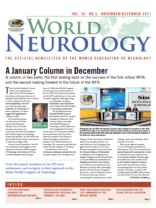By Peter J. Koehler
In a previous History column (Issue 1 in 2019), I wrote about worldwide Rockefeller Foundation (RF) Support for neurology and psychiatry in the early 20th century. Particular attention was paid to the financial support of Beijing Union Medical College and the stay of neuroanatomist C.U. Ariëns Kappers (1877-1946) and neurologist Ernst de Vries (1883-1976) in the 1920s and 1930s.
Other activities of RF included the support by the foundation of neuroscientific institutions such as the Montreal Neurological Institute (1934, over $1.2 million), the National Hospital for Diseases of the Nervous System at Queen Square (London), Otfrid Foersters Institute of Neurological Research in Breslau (1934, the present Wroclaw in Poland), the Harvard Departments of Neurology (1925, $350,000) and Psychiatry (1934), and the Nieuw Leeuwenbergh, later named Brain Center Rudolf Magnus, in Utrecht, Netherlands (1927).
As said, the RF also endorsed scientific research in and the institutional organization of psychiatry., At the time, neurology and psychiatry were often practiced in a combined fashion.
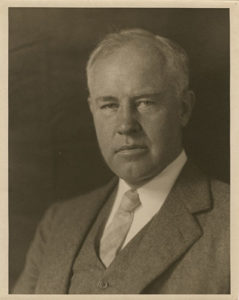
Alan Gregg (courtesy National Library of Medicine, Alan Gregg papers)
Alan Gregg and the Rockefeller Foundation
Indeed, the RF interest in neurology increased during the 1930s when psychiatry, “embracing neurology and psychology” became a significant field of interest. Departments of psychiatry, as well as those of neurology and neurosurgery, received considerable sums of money. Moreover, “the foundation maintained a steady stream of fellowships for advanced training in psychiatry, neurology, neurosurgery, and related subjects…”
These international neuroscience students included Margaret Kennard (1899-1975; see World Neurology June 2012) and Willem Verhaart (1889-1983), who spent time at John Fulton’s (1899-1960) neurophysiological lab at Yale University. With this experience, he wished to found a Primate Research Center at Batavia, the present Jakarta in Indonesia.
RF not only funded projects in the United States and Canada, but also research activities in Belgium, France, Germany, Great Britain, Holland, Norway, Sweden, and Switzerland., p.130-1 Refugee neuroscientists from Europe were helped by the RF only in a limited degree between 1933 and 1940, but this improved after 1940.
A person, who played an important role in the assignments of support was Alan Gregg (1890-1957). Between 1922 and 1956, he worked for the foundation successively as associated director in the Division of Medical Education, director of the Division of Medical Sciences, and finally as vice president of the foundation. He stimulated research in neurobiological correlates of psychiatric disorders. In his correspondence and diaries, many physicians with an interest in neurology and psychiatry are mentioned. One of them attracted my attention, notably Herman de Jong.
Herman de Jong and Experimental Catatonia
Herman de Jong was born in the Dutch city of Sneek in the northern part of the Netherlands in 1895. Following his medical studies at the University of Amsterdam, he worked at the laboratory for animal psychology of Frits JJ Buytendijk (1887-1974) at the Free University of Amsterdam.
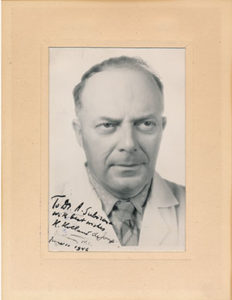
Herman (Holland) de Jong (courtesy Antonio Subirana Oller Collection, Neurosciences and History in Images)
He spent some time with psychiatrist Eugen Bleuler (1857-1939) at the Burghölzli psychiatric clinic in 1922 in Zurich. Bleuler is the person, who coined the term schizophrenia for a disease that previously was named dementia praecox. De Jong wrote his PhD thesis on catalepsy and catatonia at the University of Amsterdam in 1922.
The following year, he took a temporary position at the Central Institute of Brain Research. Between 1928 and 1940, he worked at Bernard Brouwer’s (1881-1949) department of neurology at the Amsterdam University Hospital. In 1923, Brouwer had become the first Dutch professor of neurology after Johannes CA Wertheim Salomonson (1864-1922) had died.
De Jong was a frequent presenter at meetings of the Netherlands Society of Psychiatry and Neurology. He not only presented work regarding his catatonia research, but also on all kind of neurological disorders. He published in Dutch, English, French, and German. In 1930, De Jong won the Ramaer Medal of the Netherlands Society of Psychiatry and Neurology, together with psychiatrist Henricus Cornelius Rümke (1893-1967), who became professor of psychiatry in Utrecht in 1936.
De Jong assumed catatonia, as seen in schizophrenia, to be an organic disorder and tried to create it experimentally in cats using bulbocapnine, an alkaloid compound from Corydalis cava. Bulbocapnine was later shown to act as an acetylcholinesterase inhibitor. Today, we know that catatonia is seen more often in affective disorders than schizophrenia. Moreover, it can be observed in several neurological disorders.
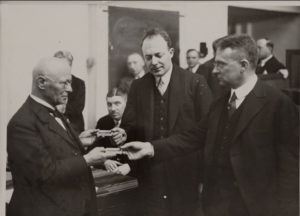
Presentation by Prof. K.H. Bouman of Ramaer Medal to De Jong en Rümke in Amsterdam, April 1930 (courtesy Beeldbank van Archief Amsterdam, Beeldbank (archief.amsterdam)
One of his teachers, namely Wertheim-Salomonson, helped him performing myograms in experimental animals and humans with catalepsy. At the time, in the concentrations used, this appeared to be normal. De Jong continued his research in Paris, where he stayed from March to June 1928 with financial support of the RF.
In his report of his stay in Paris, De Jong noted that “The person, who for the first time visits the Salpêtrière, one of the most famous centers of French clinical science, will not find the organized series of modern clinics and laboratories that one will encounter in other countries of the old and new world … and yet, it was here, where the great Charcot found his material”.
He studied chronaxie as well as experimental and clinical catatonia. He cooperated with neurophysiologist Georges Bourguignon (1876-1963), whom he called the “électro-radiologiste” at the Salpêtrière, and Henri Baruk (1897-1999). The latter was a neuropsychiatrist, trained by Joseph Babinski (1857-1932) and Achille Souques (1860-1949), who had already undertaken a systematic study of catatonia resulting in clinical data of many patients. He had concluded it was a psychomotor syndrome of toxic origin. Thus, with De Jong’s experience of the bulbocapnine experimental model and Baruk’s clinical research experience, they cooperated at Henri Claude’s (1869-1945) lab. They continued in Brouwer’s lab in Amsterdam.
“In this way, we formulated laws describing the stages that follow increasing doses, from sleep to catalepsy, from catalepsy to negativism, from negativism to hyper-kinesis, and finally, with still stronger doses, to epilepsy and the rigidity of de- cerebration”. They studied several sorts of animals up to mammals and described the results in their book La Catatonie expérimentale par la bulbocapnine: étude physiologique et Clinique., They concluded that the state inflicted by bulbocapnine indeed was similar to motor catatonia, including catalepsy, as first described by Karl Ludwig Kahlbaum (1828-1899) in 1874.
In 1925, he published “Further clinical investigations with Bulbocapnine” in cooperation with “G Schaltenbrand.” Georg Schaltenbrand (1897-1979) indeed researched the effect of bulbocapnin in Parkinson’s disease and became Oberarzt with Max Nonne (1861-1959) in 1930 after he had written his dissertation there in 1923.
He was discredited after World War II because of unethical experiments. From their experiments, De Jong concluded that “in prolonged administration Bulbocapnine is superior to Scopolamine” in the treatment of tremors (mostly Parkinson). He thanked “Prof Gadamer Marburg” who prepared the drug, probably referring to Johannes Gadamer (1867-1928), professor of chemistry, father of the philosopher Hans-Georg Gadamer (1900-2002).
It included the effect on some normal a pathological motor phenomena including tremor. Some of the patients designated “Eppendorf” were observed in the University Nerve-clinic Hamburg-Eppendorf, where Schaltenbrand was working. In 1932, De Jong wrote on hormonal experimental catatonia, searching for another substance next to bulbocapnin that could produce similar catatonic effects.
Indeed, he was searching for a toxin in catatonic schizophrenia that he named catatonin, a substance that occurs in a benzole extraction of urine that is able to produce experimental catatonia, but the findings were confusing due to “the smoking factor.” At the time, he was working at the psychological lab of the Valerius Clinic and the Free University that was directed by psychiatrist Lammert van der Horst (1893-1978).
Other, but related neurological subjects, he published were about cortical action-tremor in a case of general paralysis of the insane. At the time, he was working at the “laboratory for clinical nerve-physiology” of Brouwer’s Neurological Clinic in Amsterdam. Furthermore, he published on post-encephalitic neurological symptoms, referring to his own research on tremors between 1926 and 1928, comprising about ten articles. In 1931, he presented his work at the International Neurological Congress in Bern. However, he did not abandon working on catatonia, discovering experimental hormonal catatonia, surgical catatonia, and mescalinic catatonia. He investigated intestinal and hepatic factors, leading to the concept of hepato-intestinal factors in catatonia and schizophrenia.7
Of interest to note is that the article on experimental surgical catatonia was written in cooperation with Alfred Gallinek (1901-1975) in 1935, when the latter was already working at the Columbia-Presbyterian in New York. Gallinek had been an assistant of neuropsychiatrist Alfred Hauptmann (1881-1948), professor and director of the Psychiatric and Neurologic Clinic of the German Halle, who himself fled to the United States, via Switzerland and England, after a temporary stay at the Dachau concentration camp. Moreover, in the same article, De Jong referred to a paper he had written in cooperation with (neuro) surgeon Fedor Krause (1857-1937) in the year that the latter was given emeritus status. His cooperation with European and American researchers bear witness of his extensive network.
De Jong’s Flight to the U.S. in 1940 and Gregg’s Diary
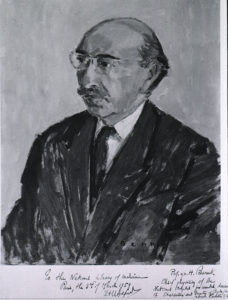
Henri Baruk (courtesy National Library of Medicine, http://resource.nlm.nih.gov/101410013)
Up to 1940, De Jong was a member of the Netherlands Society of Psychiatry and Neurology. In that year, he fled to the United States. The addition of “Holland” to his name (Herman Holland de Jong), may have been prompted by the common occurrence of the surname “De Jong.” At least one other DeJong became a neurologist, notably the well-known Russell Nelson DeJong (1907-1990), who, in 1940, was a young neurologist at the University of Michigan, to become chairman of the department in 1950. Although he too was of Dutch descent, they were probably not related.
In July 1940, Alan Gregg had lunch with him, probably in New York. He had already met De Jong in Amsterdam in June 1934 and knew about De Jong’s work on “praecox, especially catatonia” (as noted above schizophrenia’s old term was dementia praecox).
Gregg had seen a “beautiful demonstration of experimental catatonia in a cat and a mouse.” His interest in De Jong’s work should probably be understood in the context of RF’s attention for psychiatry.
“He is one of the few workers approaching resolution of praecox from chemical and physiological angle.” Regarding this lunch meeting with De Jong, Gregg noted in his diary, “Get material regarding his training and incorporate it in a letter to three or four places that might be interested in de J’s services … He has about $3,000 on which to live until he can find a position.”
Apparently, De Jong at first had plans to move further and go to the Dutch East Indies (present Indonesia), where Willem Verhaart was working. (See above.) Gregg advised him to do clinical work in the U.S. and talk with Tracy Jackson Putnam (1894-1975), co-discoverer of phenytoin treatment for epilepsy in 1938, who at the time was working at the New York Neurological Institute at Columbia University.
As vice chairman of the National Committee for Resettlement of Foreign Physicians in New York, Putnam was involved with immigrant physicians to the U.S. from Nazi Europe. A dramatic remark in Gregg’s diary is that “He [De Jong] knows nothing of his wife and two children’s whereabouts. Would be exceedingly grateful if I could write Brouwer [his Amsterdam colleague] intimating that J is safe in this country.”
A few months later, in September, Gregg noted that De Jong had learned “indirectly from Holland all is well with his family.” It has been told that his wife Marianna de Jong-Witteboon (1901-1985) refused to go aboard the ship to England in 1940, but the exact circumstances are not known. She and the two children, son Rudolf Herman and a daughter Evelyn Yvonne went to concentration camp Theresienstadt in 1944, but survived, returning to Amsterdam in 1946. They divorced in 1952. The children moved to the U.S.
As an aside, Gregg mentioned a letter to De Jong of Bielschowky’s widow, who “spoke with great appreciation of the aid B. received from the RF after leaving Germany.” Max Bielschowsky (1869-1940) was a neuropathologist, who fled from the Nazis in 1935, joining the University of Utrecht up to the German invasion in Holland in May 1940. He then fled to Spain and England, where he died in August of that year.
During the first two years, De Jong stayed in New York, working at the neurology department of New York Hospital (affiliated to Cornell University) and subsequently at the New York State Psychiatric Institute (NYSPI), where he must have met his previous co-author Gallinek. Several other European refugees had worked there. These included Franz Josef Kallman (1897-1965), who had been a student of Karl Bonhoeffer (1868-1948) and Hans-Gerhard Creutzfeldt (1885-1964) in Berlin.
Kallman wrote a book on the Genetics of Schizophrenia (1938) and led the Genetics Laboratory (1938-1961). Another refugee was Kurt Goldstein (1878-1965), who had immigrated to the U.S. in 1935. The first article that appeared in De Jong’s New York period was written in cooperation with Donald J. Simons on “fibrillation” (fasciculation) and tremor, a subject he had written about several times in his Amsterdam period. Simons was working at the New York Hospital and was assistant professor of medicine and assistant in psychiatry. Another article from his New York period, in particular at the NYSPI, was written with Louis Jacobs (1910-1989), who was at the U.S. Public Health Service (where De Jong was consultant for some time) and trained for psychiatry there.
In the Gregg diaries, we find information about De Jong in 1942, when he was trying to get a patent for a device to measure or detect extent of nerve injuries; “a machine from Dutch-American friends here in NY.” He found a position at Duke University (Durham, NC) offered by Richard S. Lyman (1891-1959), founding chairman (with RF support) of the Department of Psychiatry (1940), after Leo Alexander (1905-1985) left.
Lyman had worked at the Beijing Union Medical College (see above) in the 1930s. Alexander, of Austrian-Jewish origin, was a neuropsychiatrist, who became famous as medical advisor during the Nuremburg Trials. Gregg advised De Jong to accept the offer, as he did not see “that the RF would be prepared to give him any further help in his present position nor to promise it again in case he returned to New York after a period of time in Durham.”
Gregg assumed that his experience as a clinical and experimental neurologist would be sufficient to stay there. It would be better than staying in New York City, “where his chance of developing a clientele outside of Dutch emigrés is pretty small.” In Durham, he apparently continued his catatonia research considering his paper on the cephalin-cholesterol flocculation test in catatonic and other schizophrenics.
In 1945, he published his book Experimental Catatonia: A General Reaction-Form of the Central Nervous System and Its Implications for Human Pathology under the name Herman Holland de Jong. It received a review in Science by psychiatrist Jules H. Masserman (1905-1994), who criticized the dualistic and materialistic approach. However, he concluded that “the work represents a sincere effort to report an almost life-long series of studies by an alert, competent, and persistent investigator and, as such, will furnish significant data to those interested in the comparative investigation of normal and abnormal behavior by valid and promising methods of animal experimentation.”
In 1946, De Jong moved to Johns Hopkins University (Baltimore, Maryland), where he was associate professor at the Medical School and worked at the clinical pathology department of the Catonsville State Hospital until 1948. He may have met the influential psychiatrist Adolf Meyer (1866-1950), who retired in 1941.
A paper from this period was published in the Knickerbocker Weekly of 1947. This was a Dutch and English journal for Dutch people, who had immigrated to the U.S. before and during WWII. It was published between 1941 and 1947 by the Netherlands Publishing Corporation in New York, situated in Radio City building of Rockefeller Center. It was continued as The Knickerbocker in 1947. He then moved to the Birmingham VA Hospital in Van Nuys, California, that had been built in the early 1940s for the troops returning home from oversea service. He became chair of the psychiatry and neurology department.
De Jong died at age 61, when he was director of research and education at Kansas Osawatomie State Hospital and probably planning to cooperate with Baruk in Paris again.7 He was buried in Washington (Rock Creek Cemetery), where the remains of the two children were added. He was a member of the American Academy of Neurology and American Psychiatric Association. In one of his obituaries, he is remembered as the “father of experimental psychiatry.”
Acknowledgements: I thank Diane B. Friedman, who provided me with the Gregg diaries (Index (rockarch.org). •
P.J. Koehler MD, PhD, FAAN, edits the history column for World Neurology and is chair of Specialty Group for the History of the Neurosciences for the WFN and co-editor of Journal of the History of the Neurosciences.
E-mail: pkoehler@neurohistory.nl or p.koehler@maastrichtuniversity.nl
His website is at: www.neurohistory.nl/
Reference
-
Snodgrass SR. Stanley Cobb, the Rockefeller Foundation and the evolution of American psychiatry. Hist Psychiatry. 2018;29:438-455.
-
Angel K. Defining psychiatry: Aubrey Lewis’s 1938 report and the Rockefeller Foundation. Med Hist Suppl. 2003;22:39-56
-
Koehler P. “The orang lives almost next door” the correspondence between John Fulton (New Haven) and Willem Verhaart (Java). J Hist Neurosci. 2006;15:5-16
-
Fosdick RB. The Story of Rockefeller Foundation. New York, Transaction Publishers (original 1952 Harper), 1989.
-
Stahnisch FW, Russell GA. Forced Migration in the History of 20th Century Neuroscience and Psychiatry. New York, Routlegde, 2018.
-
De Jong H. Een studieverblijf te Parijs. Ned Tijschr Geneeskd 1929;73:187-90.
-
Baruk H. H.H. de Jong. Experimental Neurophysiologist. Science 1956;124:478.
-
De Jong H, Baruk H. La Catatonie expérimentale par la bulbocapnine: étude physiologique et clinique. Paris: Masson et Cie, 1930.
-
Starkstein SE, Goldar JC, Hodgkiss A. Karl Ludwig Kahlbaum’s concept of catatonia. Hist Psychiatry. 1995;6:201-7.
-
Shevell MI, Evans BK. The “Schaltenbrand experiment,” Würzburg, 1940: scientific, historical, and ethical perspectives. Neurology 1994;44:350-6.
-
De Jong H, Schaltenbrand G. Further clinical investigations with Bulbocapnine. Neurotherapie. Bijblad der Psychiatrische en Neurologische Bladen 1925: no.1-2:1-46.
-
De Jong H. Hormonale experimenteele Katatonie. Psychiatrische Neurologische Bladen 1932; 304-6.
-
De Jong H. Voortgezet onderzoek naar het gehalte van een in benzolisch extract van urine voorkomende stof, die experimenteele katatonie kan verwekken. Psychiatrische Neurologische Bladen 1934;38:914-20.
-
De Jong H. Corticale actie-tremor bij een geval van Dementia Paralytica. Psychiatrische Neurologische Bladen 1932;36:494-9.
-
De Jong H. Symptômes neurologiques post-encéphalitiques. Psychiatrische Neurologische Bladen 1936;40:505-17
-
De Jong, H, Gallinek A. Ueber chirurgische Katatonie. Proceedings of the Royal Academy of Sciences of Amsterdam, 1935;38:677-83.
-
Krause F, De Jong H. Über die Lokalisation einiger motorischen Erscheinungen bei der Bulbocapnin-Katatonie. Zeitschr. f. die ges. Neurol. U. Psychiat. 1931;133:754-61.
-
Zeidman LA, Ziller MG, Shevell M. Ilya Mark Scheinker: Controversial Neuroscientist and Refugee From National Socialist Europe. Can J Neurol Sci. 2016;43:334-44.
-
Stahnisch FW. Max Bielschowsky (1869-1940). J Neurol 2015;262:792-4.
-
Holdorff B. Emigrated neuroscientists from Berlin to North America. J Hist Neurosci. 2016;25:227-52.
-
De Jong H, Simons DJ. A comparative study of fibrillation and tremor. JAMA 1942;118:702-5.
-
De Jong H, Jacobs L. A contribution to the differential diagnosis of myoclonus. J Nerv Ment Dis. 1944;99:290-7.
-
De Jong H, John J. The cephalin-cholesterol flocculation test in catatonic- and other schizophrenics. J Nerv Ment Dis. 1945;101:572-5.
-
De Jong HH. Experimental Catatonia: A General Reaction-Form of the Central Nervous System and Its Implications for Human Pathology.Baltimore, Williams & Wilkins, 1945
-
Masserman JH. Book review of De Jong HH. Experimental Catatonia: A General Reaction-Form of the Central Nervous System and Its Implications for Human Pathology. Science 1946;103:28.
-
Schijns OEMG, Koehler PJ. Adolf Meyer: the neuroanatomist and neuropsychiatrist behind Meyer’s loop and its significance in neurosurgery. Brain. 2020;143:1039-44.
-
De Jong H. A report on physical and mental health in the Netherlands after the war. Knickerbocker Weekly 1947; no. 4.
-
Obituary H. Holland de Jong, M.D. (1895-1956). Arch Neurol Psychiatry 1956;75:573.
